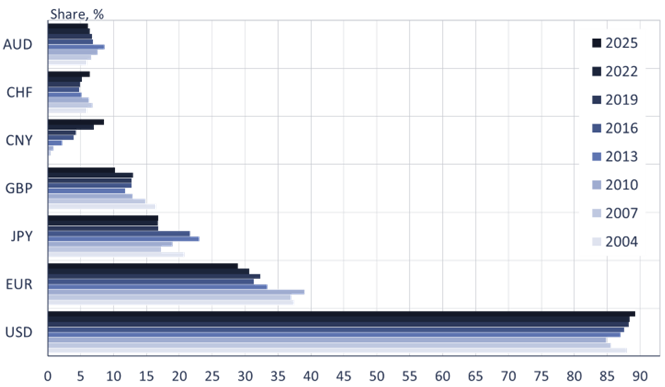BOFIT Weekly Review 40/2025
The yuan’s share in international FX trading continues to grow
In September, the Bank for International Settlements (BIS) released results of its 2025 Triennial Central Bank Survey about foreign exchange (FX) and over-the-counter (OTC) derivatives markets. The yuan’s use in currency trading increased from 7 % in 2022 to 8.5 % in 2025. The yuan remained the world’s fifth-most traded currency. The United States dollar, which increased its share as the world’s most traded currency, was found to be one side of 89.2 % of all transactions (88.4 % in 2022). The euro’s share declined slightly, but remained the second-most traded currency at 28.9 % (30.6 % in 2022). The share of the Japanese yen remained virtually unchanged at 16.7 %, while the British pound’s share fell to 10.2 % (12.9 % in 2022). The Hong Kong dollar was the ninth-most traded currency with a 3.8 % share, and the Indian rupee’s share was 1.9 % in 11th position. Because each transaction involves two currencies, the sum of the percentage shares of individual currencies totals 200 %.
Over 1,100 banks and dealers in 52 countries participated in the BIS survey in April of this year. The average daily volume of foreign exchange trading in April was 28 % higher than in the previous survey conducted in 2022. At the same time, the yuan trading volume increased by 56 %. Almost all yuan trading is conducted in relation to the US dollar. The USD/CNY currency pair accounted for 8.1 % of all turnover, surpassing even USD/GBP trades (7.6 %). The USD/EUR pairing remained the most traded with a 21.2 % share, followed by the USD/JPY pair (14.3 %). The most significant trading pair not involving the dollar was the EUR/GBP trade with a 1.8 % share. Most international FX trading is conducted through FX swaps or spot transactions. This also holds for yuan trading.
The United Kingdom remained the world’s top FX trading hub, accounting for over a third of all global currency trading. The next largest trading centres were the US, Singapore and Hong Kong. These four markets accounted for three-quarters of all the FX trading covered in the BIS survey. Only 17 % of yuan FX trading took place in mainland China. The largest yuan trading hubs were Hong Kong (30 % of trades) and the UK (22 %). Other hubs for yuan trading were Singapore (14 %) and the US (13 %). Yuan FX trading is minimal elsewhere. In April, 78 % of the value of mainland China’s FX trade involved the yuan, 97 % the dollar, and 9 % the euro. Correspondingly, in Hong Kong the USD accounted for 97 % of the value traded, 36 % for the yuan, 22 % for the Hong Kong dollar and 11 % for the euro. Ruble trading in mainland China and Hong Kong was extremely small.
The yuan’s share in international currency trading has increased substantially over the past two decades

Sources: BIS and BOFIT. Note: Because two currencies are involved in each transaction, the sum of the percentage shares of individual currencies totals 200%.